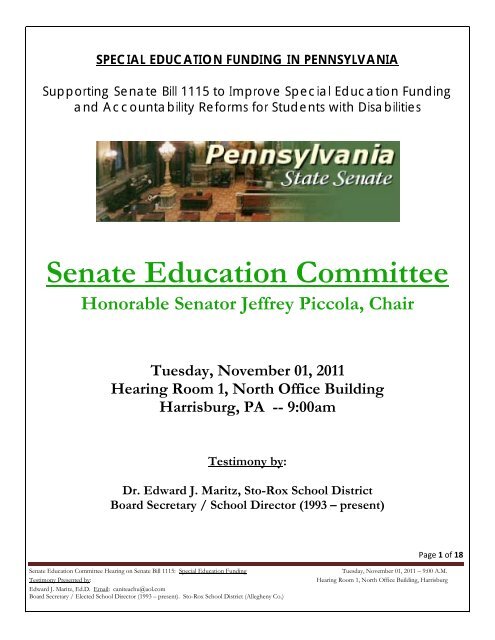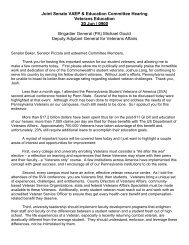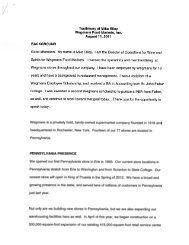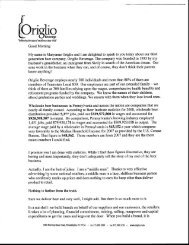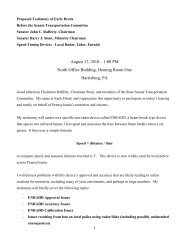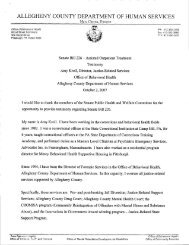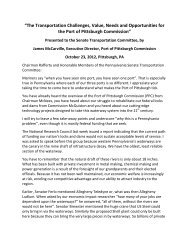Dr. Edward J. Maritz
Dr. Edward J. Maritz
Dr. Edward J. Maritz
You also want an ePaper? Increase the reach of your titles
YUMPU automatically turns print PDFs into web optimized ePapers that Google loves.
SPECIAL EDUCATION FUNDING IN PENNSYLVANIASupporting Senate Bill 1115 to Improve Special Education Fundingand Accountability Reforms for Students with DisabilitiesSenate Education CommitteeHonorable Senator Jeffrey Piccola, ChairTuesday, November 01, 2011Hearing Room 1, North Office BuildingHarrisburg, PA -- 9:00amTestimony by:<strong>Dr</strong>. <strong>Edward</strong> J. <strong>Maritz</strong>, Sto-Rox School DistrictBoard Secretary / School Director (1993 – present)Page 1 of 18Senate Education Committee Hearing on Senate Bill 1115: Special Education FundingTestimony Presented by:<strong>Edward</strong> J. <strong>Maritz</strong>, Ed.D. Email: caniteachu@aol.comBoard Secretary / Elected School Director (1993 – present). Sto-Rox School District (Allegheny Co.)Tuesday, November 01, 2011 – 9:00 A.M.Hearing Room 1, North Office Building, Harrisburg
2011 Sto-Rox Board of School Directors600 Russellwod Avenue Ms. Elizabeth Smith, President Mrs. Kelly Cropper-Hall, Vice-PresidentMcKees Rocks, PA 15136 <strong>Dr</strong>. <strong>Edward</strong> J. <strong>Maritz</strong>, Board Secretary Mrs. Luanne Schipani, Treasurer412-771-3213 ext. 5236 Ms. June Fleming Mr. Kevin KochirkaBoard@srsd.k12.pa.us Mr. Timothy Haines Ms. Jeanne HughesVisit us at: www.srsd.k12.pa.us Mrs. Jean Mayes <strong>Dr</strong>. Michael Panza, SuperintendentNovember 01, 2011:I would like to take this opportunity to thank the Honorable Chairman Senator Piccola for this opportunity to testify at this SenateEducation Committee Meeting. I am honored to join with the other testifier’s, experts, and concerned stakeholders in examiningspecial education funding in Pennsylvania. My testimony is offered in full support of SB1115. Over the last two decades it hasbecome universally understood that most school districts in Pennsylvania currently do not have the adequate resources needed toprovide a quality education to students with disabilities. Some research on special education funding has identified as many as 391school districts with inadequate funding streams for special education.The Sto-Rox School District is one such district that does not currently have the adequate resources needed to provide a qualityeducation to students with disabilities. Within this testimony I will provide information regarding the Sto-Rox School District(Allegheny County) where I have served as an elected school director since 1993. The Sto-Rox School District is substantiallyimpacted by the inequities of Special Education funding. The percentage of our Special Education population compared to totalenrollment is well above the statewide average and is second highest in Allegheny County. Yet, our special education subsidiesreceived, per pupil, are the second lowest in Allegheny County. [See Tables 2 & 3 on Pages 13 & 14].As the attached testimony will provide, Sto-Rox students are the victims of an outrageously flawed special education financesystem. Here at Sto-Rox we remain deeply committed to providing a high quality public education for all students, including ourmost vulnerable students, those with disabilities. It is my sincere hope that this Senate Education Committee meeting is a criticalfirst step toward realizing meaningful special education funding reform.I want to again personally thank Honorable Senator Piccola and all of the Honorable Senators on the Senate Education Committeefor this opportunity to testify and get the story of Sto-Rox heard. I owe gratitude to Hon. Senator Wayne Fontana for affording methe opportunity to be considered as a candidate to deliver testimony. I am grateful to Mr. Matt Azeles, Deputy Director of theSenate Education Committee for his assistance with matters of procedure and protocol. In addition, I wish to thank Mr. FrankDalmas, Sto-Rox Director of Pupil Services, Mr. <strong>Edward</strong> Yorke, Sto-Rox Business Manager and Superintendent <strong>Dr</strong>. Michael Panzafor their assistance with district specific internal data. Finally, and most important, I am most grateful to Sto-Rox School BoardPresident Elizabeth Smith who provided invaluable assistance in the data collection, analysis, and editing of this testimony.It remains my belief that as a locally elected school director an important part of my board service is to work together with thehonorable legislators of the General Assembly to raise awareness of this issue so that together we can help usher in a new day forSpecial Education Funding in Pennsylvania.Respectfully submitted,<strong>Edward</strong> J. <strong>Maritz</strong>, Ed.D.Board Secretary / Elected School Director, Sto-Rox SD (1993-present)Page 2 of 18Senate Education Committee Hearing on Senate Bill 1115: Special Education FundingTestimony Presented by:<strong>Edward</strong> J. <strong>Maritz</strong>, Ed.D. Email: caniteachu@aol.comBoard Secretary / Elected School Director (1993 – present). Sto-Rox School District (Allegheny Co.)Tuesday, November 01, 2011 – 9:00 A.M.Hearing Room 1, North Office Building, Harrisburg
Sto-Rox School District(Allegheny County)District Enrollment 1406 Free & Reduced Eligible: 83% of all Students.[As per District Report Filed with PDE]Entire District Operating Budget for 2009-2010 $23,776,719 Special Ed Costs Represent Nearly 20% of our entireOperating BudgetSpecial Education Enrollment 371 26% of all Students (Statewide Average is 16%)Aid Ratio .7700Community Population (2010 Census Data) 13,328 Residents Below Poverty Level: (2010 Census)2538 (19% of Entire School Community Lives Below Poverty.)Actual Special Education Expenditures 09-10 (Audited/AFR Reported) $3,734,909.34 Total Special Education CostsActual Special Education Subsidy 09-10 SY (Audited/AFR Reported) - $1,033,312.44 Actual Special Education Subsidy ReceivedDIFFERENCE (cost over subsidy) =$2,701.596.90 A 2.8 Million Dollar Shortfall in Special EducationActual Charter School Expenditures (2009-2010) (Audited) $1,981,001.13 Propel, Etc.Actual Charter School Reimbursements (2009-2010) (Audited) -$ 610,772.95 State Subsidy Reimbursement for Charter SchoolsDIFFERENCE (Charter School Cost,less Reimbursements)= $1,370,228.18 Sto-Rox Taxpayers pay the difference, orroughly $1.3 Million Dollars, for Charter SchoolsEQUALIZED MILLAGE RATE 2009-2010(Value of a mill at Sto-Rox is approximately $275,000)(Collection Rates are in the low 90% range)29.611th Highest Taxed Statewide out of 500 SD’s!The Sto-Rox District is not unwilling to Tax. Wesimply are unable to Tax our residents any further!Page 3 of 18Senate Education Committee Hearing on Senate Bill 1115: Special Education FundingTestimony Presented by:<strong>Edward</strong> J. <strong>Maritz</strong>, Ed.D. Email: caniteachu@aol.comBoard Secretary / Elected School Director (1993 – present). Sto-Rox School District (Allegheny Co.)Tuesday, November 01, 2011 – 9:00 A.M.Hearing Room 1, North Office Building, Harrisburg
Students with Disabilities in Pennsylvania Deserve: Specialized Early Intervention Services. Robust School-Wide Behavioral Support Programs to encourage responsible choices. Expanded Programming such as after-school and extended school year services. An education that increases chances of post-graduation success thereby lowering societal expenses.Students with Disabilities in Pennsylvania Currently Endure: Insufficient Funding for Special Education, which increases strain on the quality of special education. Increasing class sizes, which diminish additional time and effort available per student. Delayed Replacement of Textbooks and Instructional Supports exposing them to antiquated materials. Inadequate Instructional Support Materials such as Technology and Library Services.With Adequate Special Education FundingPennsylvania Will Provide Students with Disabilities: Increased Professional Development for all Teachers, particularly those in Inclusionary Classrooms. Increased Professional Development and Specialized Training for Education Support Personnel. Intensive staff training on urban education and societal challenges germane to poor inner-city areas. Intensive training on the educational challenges of students deriving from broken family structures.SB1115 PROVIDES AN IMPORTANT STARTING POINT SOLUTION!Page 4 of 18Senate Education Committee Hearing on Senate Bill 1115: Special Education FundingTestimony Presented by:<strong>Edward</strong> J. <strong>Maritz</strong>, Ed.D. Email: caniteachu@aol.comBoard Secretary / Elected School Director (1993 – present). Sto-Rox School District (Allegheny Co.)Tuesday, November 01, 2011 – 9:00 A.M.Hearing Room 1, North Office Building, Harrisburg
Formal Oral Testimony: (Pages 5-9)I would like to again thank the Senate Education Committee Chair Honorable Senator Piccola for commencing this SenateEducation Committee Meeting to address the topic of how special education is funded in Pennsylvania. My name is <strong>Edward</strong> <strong>Maritz</strong> andI’ve been a School Director in the Sto-Rox School District since 1993. Our District is a small, poor school district wrestling with varioussocietal challenges that are germane to inner-city urban areas. Our district struggles began with the collapse of the steel mill industry inPittsburgh in the early 1980’s. Like many former rust-belt communities with declining industrial tax bases, many of our families andstudents are deeply impacted by poverty.Sto-Rox is the victim of an outrageously flawed special education funding system. Toward this end, nearly 20% of our entireschool district operating budget is devoted toward special education programming. Given the socio-economic status of our communities,we place a high premium on our ability to programmatically meet the needs of all learners. At Sto-Rox, we encounter a substantialnumber of parents (or single parent families) who have low levels of education or little time to spend with their children due toemployment considerations or other factors. We have great concern for our students and worry about their nutrition, basic health care,non-functional families, teenage pregnancy, dropout rates, and dependency on drugs and alcohol, as well as suicide and depression.Our student population comprises 1400 students and we realize high incidence rates of special education students whom are bothexpensive and difficult to educate. Our current special education population is 26% which is well above the assumed statewide averageof 16%. This increases the need for our school district to offer a high quality education, as this is crucial to our student’s intellectualdevelopment. Within the Sto-Rox School District, many of our students come from broken family structures where the parent’seducational level is low and the family income is lower yet. This leads to an oft-cited criticism that (additional) school funding does notlead to improved achievement. However, the unique complexities of our community produce a student population that is both expensiveand challenging to educate.The greatest travesty occurs with the inequity of special education funding in Pennsylvania. State subsidies for specialeducation cover only one-quarter of our overall special education expenses. For example, our special education expenditures for ourlast fiscal year were $3.8 million dollars and special education subsidy revenues from the state were just $1 million dollars. As such,local taxpayers were required to fund this $2.8 million dollar shortfall as listed on Table 1, found on Page 12. This 2.8 million dollarshortfall causes a significant strain on the entire school district budget. Comparatively, to fund this shortfall locally, we wouldneed to levy TEN MILLS of property taxes (with a collection value of only $275,000 per mill) to fund this special educationsubsidy shortfall. These factors are further explored in Table 7.Toward the end of this testimony there are two comparative analyses in Tables 2 & 3, found on pages 13 and 14 respectively,which delineate all of Allegheny County’s Special Education incidence rates and subsides. Sto-Rox has the 2nd HIGHEST incidence rateof special education students in ALL of Allegheny County, standing at 26.4%. Comparatively, we receive the 2 nd LOWEST subsidy perpupil at $2,764 per special education student.Page 5 of 18Senate Education Committee Hearing on Senate Bill 1115: Special Education FundingTestimony Presented by:<strong>Edward</strong> J. <strong>Maritz</strong>, Ed.D. Email: caniteachu@aol.comBoard Secretary / Elected School Director (1993 – present). Sto-Rox School District (Allegheny Co.)Tuesday, November 01, 2011 – 9:00 A.M.Hearing Room 1, North Office Building, Harrisburg
The Commonwealth’s ongoing failure to provide adequate and equitable resources for Special Education negatively impactsALL students in our school district and not just those with disabilities. When Districts are faced with substantial deficiencies in fundingfor special education, ALL of the districts expenditures become strained, resulting in insufficient resources being allocated district wide.In terms of basic support for schools, the General Assembly would be wise to consider appropriating targeted impact aid or, at minimum,a special appropriation to school districts that display extraordinarily high tax effort to support their schools. At Sto-Rox, we are notunwilling to tax our residents. The reality is we are unable to tax any further for fear that our citizens may lose their homes to tax sheriffsales. Sto-Rox currently ranks ELEVENTH HIGHEST STATEWIDE out of 500 school districts for overall tax effort using 2009-2010 PDE statewide-equalized millage rates.The most significant equity issue affecting Sto-Rox is special education funding. We can no longer ignore years of researchabout incidence rates of special education students. We must be sensitive to the fact that poverty not only impacts upon achievement,but also impacts the incidence rates of special education populations. High poverty rates, low birth weights, lack of prenatal care, lack ofproper nutrition and unavailability of health care are all directly related to the incidence rates of special education students. Theapplication of funding special education based upon assumed mean incidence rates utilizing statewide averages punish poor districtswith little impact being realized in affluent districts.I commend Honorable Senators Browne and Dinniman and all of the co-sponsors of Senate Bill 1115 for recognizing the needto reform special education funding in Pennsylvania. Senate Bill 1115 can work in tandem with other educational reforms whilestrengthening schools and reducing pressure on local property taxes. Senate Bill 1115 is poised to bring true reform to special educationfunding in that it counts real students rather than erroneously assuming every district has the same percentage of special educationstudents. If adopted, this bill would finally change the way Pennsylvania funds special education. Senate Bill 1115 finally recognizes thatthe special education incidence rate in many school districts often increases and the bill applies its funding based upon actual studentcounts, with accountability measures built into the law to guard against over-identification. It also fixes the woefully inadequate specialeducation contingency fund. The contingency fund, if appropriately administered, can assist those districts with extraordinary expensesfor the most costly students that no simple formula could account for regarding the relative severity of a student’s disability, or the typesof services students actually receive.The current Special Education funding system in Pennsylvania is a broken system that continues to tolerate vast inequitiesamong our state’s 500 school districts. The education of our children should NOT rely on a funding system that is directly correlated tothe relative wealth of its community. The educational outcomes of children should NOT be predisposed by the financial circumstances ofa child’s community nor should such a system predispose the destiny of its children. Taxpayers in the Sto-Rox School District fund theirschools from their need, while many of our wealthy counterparts in suburbia are still funding their schools from their excess.Our great commonwealth is a very diverse state. In Pennsylvania, there are many school districts which are districts that aresituated in poverty-stricken communities which are simultaneously surrounded by communities that are “pockets” of wealth.It is not at all uncommon to have a “poor” school district neighboring a more “wealthy” school district. To be a poor school district meansthat you are forced to “live within your means” or face going distressed. An example illustrates this point. If we at Sto-Rox wanted to hirean additional guidance counselor at $50,000 and did not have budgeted money available for it, we could not spend those dollars onguidance services or we would be over-spending and mismanaging our school district. However, if our neighboring school district inMontour wanted to renovate its football field and install astro-turf football field at a cost exceeding one-million dollars, which it did, theywhere able to spend this money because they a budget surplus readily available to them. After all, both school districts are simply “livingwithin their means,” whether or not that is good for the educational program is apparently irrelevant in Pennsylvania.Page 6 of 18Senate Education Committee Hearing on Senate Bill 1115: Special Education FundingTestimony Presented by:<strong>Edward</strong> J. <strong>Maritz</strong>, Ed.D. Email: caniteachu@aol.comBoard Secretary / Elected School Director (1993 – present). Sto-Rox School District (Allegheny Co.)Tuesday, November 01, 2011 – 9:00 A.M.Hearing Room 1, North Office Building, Harrisburg
Sto-Rox used to be a middle-income community with a thriving industrial tax base. Over the last 25 years, heavy industry fellapart, people moved to suburbia, and state support for schools fell flat. Sto-Rox is currently situated as a district in a pocket of poverty,which is surrounded by a district that is situated in a pocket of wealth, that being the Montour School District. Our neighboring suburbandistrict has a current fund balance in excess of $24 million dollars, which is the equivalent size of Sto-Rox’s entire operating budget!Money matters with regard to providing high quality services to students with disabilities. Wealthier school districts are easilyable to spend more on special education. The resultant effect is better outcomes for those students. In a poor school district like Sto-Rox, students with disabilities are underserved, or worse, under identified. Special Education is one of the fastest growing expenditureline items for school districts today, and continued flat funding by the state falls far short of covering the actual expenses incurred bySchool Districts. This merely shifts the burden to local property tax payers as Table 7 illustrates.The [additional and temporary] federal stimulus funds from IDEA did not provide long-term solutions. Truth be told, Federalstimulus dollars for IDEA were intended to supplement, not supplant, State funding. These Federal Stimulus Dollars for IDEA wereintended to be utilized for “one- shot spending” that would produce “a long-term effect.” However, as any school practitioner will tell you,that doesn’t include the day to day needs of students with IEP’s for services that Districts will not be able to sustain beyond the stimulusdollars. These facts underscore why long-term solutions are sorely needed for Special Education funding.The Commonwealth’s share of special education funding is woefully inadequate currently covering only 32 cents on everydollar. Throughout my 18 years of service as a school director, I’ve witnessed funding for special education fall substantially behind thatof regular education. According to a 2005 report by the Build Initiative on the “Cost Savings to Special Education from Pre-Schooling inPennsylvania,” the proportion of children eligible for special education services has grown from 8% in 1975 to 14% in 2003. Whileidentification of students requiring special education has increased at the primary grade levels, so have the expenditures to provide suchservices. Overall, statewide, students with disabilities are identified at an increased growth rate of about 2.5% per year. Yet, despitethe growth in identification and the inflationary increases in costs to provide such services, Pennsylvania has “flat-funded” specialeducation subsidies for nearly five years now with annual average increases barely reaching 1% in the special education subsidy. If anyfunding formula is deemed to be truly objective and serve its intended purpose, then no one can be entirely satisfied. Compromising afunding formula for political expediency is not the way to reform education funding in Pennsylvania, and that is exactly whatPennsylvania’s current special education funding system is, a compromised system that, while politically expedient, ends up harming theeducation of students with disabilities and this simply can no longer be tolerated.Understandably, the goal of any increase in state funding would be to ensure that all students meet state academic standards.However, students with disabilities have higher costs to educate than regular education students as there are excess costs to providestudents with disabilities needed basic instructional materials, services, equipment, technology, and personnel. The resultant effect ofthese realties lays bare a special education funding system in Pennsylvania that long has been known to be broken, unfair, and unable toprovide the adequate resources needed for special education in districts that need the most help. The current census based approachutilizing assumed statewide mean average incidence rate percentages negatively impacts students with disabilities in districts with aboveaverage incidence rates.Page 7 of 18Senate Education Committee Hearing on Senate Bill 1115: Special Education FundingTestimony Presented by:<strong>Edward</strong> J. <strong>Maritz</strong>, Ed.D. Email: caniteachu@aol.comBoard Secretary / Elected School Director (1993 – present). Sto-Rox School District (Allegheny Co.)Tuesday, November 01, 2011 – 9:00 A.M.Hearing Room 1, North Office Building, Harrisburg
It is important to understand that the problems with special education funding are not isolated. For well over a decade,Pennsylvania has provided local communities the option of forming Charter Schools as an alternative to local public schools.Truth be told, Pennsylvania’s inadequate special education funding also has an indirect impact on Charter Schools. As you are aware,Pennsylvania’s public schools do not receive special education funding that is directly tied to the numbers of students with disabilitiesserved within the public schools. Instead, public schools receive funding based upon a statewide assumed mean average. However,Pennsylvania’s Charter Schools receive FULL funding (directly from the public school) for the excess cost of educating a student with adisability in the Charter School. Therefore, Pennsylvania’s current unfair system of special education funding complicates the charterschool process and in many cases it causes significant animosity and divides schools, taxpayers, and other community stakeholdersfrom the charter school concept.The current broken and unfair funding system for special education in our Commonwealth is arguably an attributing factor tocausing school districts like Sto-Rox financial distress. Few in the General Assembly can deny that the special education fundingsystem needs to be fixed and proposals like Senate Bill 1115 set us on this path. If this legislature has truly committed itself to helpingfinancially distressed districts, revamping property taxes, restructuring charter schools, and doing what works for all students, thenSenate Bill 1115 cannot be ignored. It is patently unfair to allow a population of students with the greatest needs to be flat funded forseveral years while related services and costs continue to rise. The flat funding of special education forces poorer districts to pull awayresources from regular education.It is not at all lost on me, and I’m entirely sensitive to the fact that as Senators you’ve long grown accustomed to hearing pleasfrom educators for more money. However, Senate Bill 1115 isn’t just about more money—it’s about a critical part of public education thathas long tolerated a special education funding mechanism that is unfair. As elected officials in positions of trust and authority, we do adisservice to parents, communities, educators, and most of all to the most vulnerable students we have—students with disabilities.Quite simply stated, we can no longer ignore the fact that Pennsylvania has allowed special education funding to take a “back seat” toother education priorities in the State and for too long the special education subsidy has been grossly ignored while other improvementswere being made to basic education.Compounding matters, Pennsylvania’s current census based approach to special education funding further exacerbates theproblem of our state’s unfair property tax system, as school districts situated in high poverty areas have the greatest need whilesimultaneously having the fewest resources upon which to draw. The Sto-Rox School District has proven that it can deliver results withadditional funding. We were recognized by PDE as one of the 50 School Districts statewide demonstrating the most improvement since2002. Furthermore, Sto-Rox was initially one of the Eleven Empowerment Districts identified in Act 16 of 2000. We worked very hardand were able to demonstrate successful academic achievement gains to be removed from the Empowerment list in 2004. The targetedimpacted aid of empowerment dollars mattered then and targeted aid for improvements in special education funding will matter today.Page 8 of 18Senate Education Committee Hearing on Senate Bill 1115: Special Education FundingTestimony Presented by:<strong>Edward</strong> J. <strong>Maritz</strong>, Ed.D. Email: caniteachu@aol.comBoard Secretary / Elected School Director (1993 – present). Sto-Rox School District (Allegheny Co.)Tuesday, November 01, 2011 – 9:00 A.M.Hearing Room 1, North Office Building, Harrisburg
In closing, I would like to again thank Honorable Chairman Piccola for the invitation to testify at this hearing today to addressthe topic of how special education is funded in Pennsylvania. I commend Honorable Senators Browne and Dinniman and all of the cosponsorsof Senate Bill 1115 for recognizing the need to reform special education funding in Pennsylvania. Senate Bill 1115 can work intandem with other educational reforms while strengthening schools and reducing pressure on local property taxes.Senators Browne and Dinniman, your honorable legislative work and introduction of Senate Bill 1115 means a great deal tomany people in Pennsylvania that you may never meet, nor may they ever know who you are or what you have done. However, yourlegislation is poised, over time, to dramatically improve their lives and the lives of many Pennsylvania students with disabilities. It is myhope that today’s efforts will be a starting point to bring about educational equity for all Pennsylvania school age children. Thank you foryour bold leadership and service to our great Commonwealth.Respectfully submitted,<strong>Edward</strong> J. <strong>Maritz</strong>, Ed.D., Sto-Rox School DistrictBoard Secretary / Elected School Director (1993-present)Page 9 of 18Senate Education Committee Hearing on Senate Bill 1115: Special Education FundingTestimony Presented by:<strong>Edward</strong> J. <strong>Maritz</strong>, Ed.D. Email: caniteachu@aol.comBoard Secretary / Elected School Director (1993 – present). Sto-Rox School District (Allegheny Co.)Tuesday, November 01, 2011 – 9:00 A.M.Hearing Room 1, North Office Building, Harrisburg
NOTES:________________________________________________________________________________________________________________________________________________________________________________________________________________________________________________________________________________________________________________________________________________________________________________________________________________________________________________________________________________________________________________________________________________________________________________________________________________________________________________________________________________________________________________________________________________________________________________________________________________________________________________________________________________________________________________________________________________________________________Page 11 of 18Senate Education Committee Hearing on Senate Bill 1115: Special Education FundingTestimony Presented by:<strong>Edward</strong> J. <strong>Maritz</strong>, Ed.D. Email: caniteachu@aol.comBoard Secretary / Elected School Director (1993 – present). Sto-Rox School District (Allegheny Co.)Tuesday, November 01, 2011 – 9:00 A.M.Hearing Room 1, North Office Building, Harrisburg
TABLE 2: Ranking of 08-09 Special Education Incidence Rate Percentages for All of Allegheny County 2 TABLE 2:Rankof theHighest %of SpecEd.Enrollment School District County2008-2009Spec. Ed.Enrollment2008-2009Enrollment2008-2009SEF SubsidySpec. Ed. %of TotalEnrollment2008-2009 Per PupilFunding as apercentage of Spec.Ed. Enrollment1 Clairton City SD Allegheny 231 793 $993,228 29.1% $4,3002ndHIGHEST Sto-Rox SD Allegheny 371 1,406 $1,025,580 26.4% $2,7643 Wilkinsburg Borough SD Allegheny 367 1,453 $1,135,688 25.3% $3,0954 Duquesne City SD Allegheny 122 502 $611,994 24.3% $5,0165 Cornell SD Allegheny 145 676 $419,764 21.4% $2,8956 Woodland Hills SD Allegheny 898 4,343 $3,332,872 20.7% $3,7117 Pittsburgh SD Allegheny 5,600 28,104 $27,305,507 19.9% $4,8768 Penn Hills SD Allegheny 955 4,972 $2,963,257 19.2% $3,1039 Shaler Area SD Allegheny 964 5,061 $3,146,384 19.0% $3,26410 Highlands SD Allegheny 531 2,827 $1,751,842 18.8% $3,29911 East Allegheny SD Allegheny 350 1,888 $1,090,189 18.5% $3,11512 Steel Valley SD Allegheny 337 1,869 $1,261,004 18.0% $3,74213 Northgate SD Allegheny 229 1,296 $815,675 17.7% $3,56214 Gateway SD Allegheny 710 4,067 $1,940,931 17.5% $2,73415 McKeesport Area SD Allegheny 691 3,966 $2,899,898 17.4% $4,19716 South Allegheny SD Allegheny 266 1,599 $1,048,670 16.6% $3,94217 Carlynton SD Allegheny 242 1,464 $825,803 16.5% $3,41218 Deer Lakes SD Allegheny 322 1,977 $1,149,690 16.3% $3,57019 Riverview SD Allegheny 179 1,111 $630,299 16.1% $3,52120 West Mifflin Area SD Allegheny 508 3,258 $1,829,358 15.6% $3,60121 West Allegheny SD Allegheny 495 3,249 $1,538,698 15.2% $3,10822 Fox Chapel Area SD Allegheny 675 4,469 $2,314,902 15.1% $3,42923 Bethel Park SD Allegheny 720 4,822 $2,404,500 14.9% $3,34024 Montour SD Allegheny 439 3,009 $1,583,131 14.6% $3,60625 Allegheny Valley SD Allegheny 167 1,145 $663,023 14.6% $3,97026 North Hills SD Allegheny 637 4,431 $2,227,385 14.4% $3,49727 Keystone Oaks SD Allegheny 314 2,227 $1,403,527 14.1% $4,47028 Brentwood Borough SD Allegheny 177 1,258 $767,009 14.1% $4,33329 Moon Area SD Allegheny 516 3,683 $1,577,697 14.0% $3,05830 Quaker Valley SD Allegheny 265 1,931 $784,414 13.7% $2,96031 Upper Saint Clair SD Allegheny 548 4,107 $1,743,344 13.3% $3,18132 Elizabeth Forward SD Allegheny 348 2,679 $1,641,184 13.0% $4,71633 Avonworth SD Allegheny 169 1,395 $676,246 12.1% $4,00134 Mt Lebanon SD Allegheny 636 5,287 $2,477,734 12.0% $3,89635 West Jefferson Hills SD Allegheny 337 2,849 $1,677,744 11.8% $4,97836 Baldwin-Whitehall SD Allegheny 483 4,180 $2,444,767 11.6% $5,06237 Chartiers Valley SD Allegheny 371 3,402 $1,443,104 10.9% $3,89038 Pine-Richland SD Allegheny 493 4,523 $1,485,391 10.9% $3,01339 South Park SD Allegheny 235 2,164 $1,120,189 10.9% $4,76740 Hampton Township SD Allegheny 332 3,091 $1,440,068 10.7% $4,33841 Plum Borough SD Allegheny 434 4,214 $2,205,554 10.3% $5,08242 North Allegheny SD Allegheny 829 8,065 $3,618,200 10.3% $4,36543 South Fayette Twp SD Allegheny 192 2,279 $858,240 8.4% $4,470Special Education Incidence Rate Percentages:Based on percentage of enrollment, the Sto-Rox School District has the second highest percentage of special education students, as compared to total enrollment, ofall school districts in Allegheny County. The Sto-Rox School District's percentage of special needs students is 26.4%. Among the County districts, the range ofspecial ed. populations is from a low of 8.4% to a high of 29.1%.2 Former Sto-Rox Director of Administrative Services Mr. Charles J. Lanna compiled data above. Formatting compiled by Testimony Author..Senate Education Committee Hearing on Senate Bill 1115: Special Education FundingTestimony Presented by:<strong>Edward</strong> J. <strong>Maritz</strong>, Ed.D. Email: caniteachu@aol.comBoard Secretary / Elected School Director (1993 – present). Sto-Rox School District (Allegheny Co.)Page 13 of 18Tuesday, November 01, 2011 – 9:00 A.M.Hearing Room 1, North Office Building, Harrisburg
TABLE 3: Ranking of Special Education Per-Pupil Subsidy based on 08-09 Incidence Rates for Allegheny County 3 TABLE 3Rank Orderof HighestSpec. Ed.Subsidy PerPupil AUN School District County2008-2009Spec. Ed.Enrollment2008-2009Enrollment2008-2009ProposedSEFSpec. Ed. %of TotalEnrollment08-09Funding per08-09 Spec.Ed.Enrollment1 st Highest 103027503 Plum Borough SD Allegheny 434 4,214 $2,205,554 10.3% $5,0822 103021102 Baldwin-Whitehall SD Allegheny 483 4,180 $2,444,767 11.6% $5,0623 103022503 Duquesne City SD Allegheny 122 502 $611,994 24.3% $5,0164 103029553 West Jefferson Hills SD Allegheny 337 2,849 $1,677,744 11.8% $4,9785 102027451 Pittsburgh SD Allegheny 5,600 28,104 $27,305,507 19.9% $4,8766 103028753 South Park SD Allegheny 235 2,164 $1,120,189 10.9% $4,7677 103023153 Elizabeth Forward SD Allegheny 348 2,679 $1,641,184 13.0% $4,7168 103028703 South Fayette Twp SD Allegheny 192 2,279 $858,240 8.4% $4,4709 103025002 Keystone Oaks SD Allegheny 314 2,227 $1,403,527 14.1% $4,47010 103026852 North Allegheny SD Allegheny 829 8,065 $3,618,200 10.3% $4,36511 103024603 Hampton Township SD Allegheny 332 3,091 $1,440,068 10.7% $4,33812 103021453 Brentwood Borough SD Allegheny 177 1,258 $767,009 14.1% $4,33313 103021903 Clairton City SD Allegheny 231 793 $993,228 29.1% $4,30014 103026002 McKeesport Area SD Allegheny 691 3,966 $2,899,898 17.4% $4,19715 103020753 Avonworth SD Allegheny 169 1,395 $676,246 12.1% $4,00116 103020603 Allegheny Valley SD Allegheny 167 1,145 $663,023 14.6% $3,97017 103028653 South Allegheny SD Allegheny 266 1,599 $1,048,670 16.6% $3,94218 103026402 Mt Lebanon SD Allegheny 636 5,287 $2,477,734 12.0% $3,89619 103021752 Chartiers Valley SD Allegheny 371 3,402 $1,443,104 10.9% $3,89020 103028833 Steel Valley SD Allegheny 337 1,869 $1,261,004 18.0% $3,74221 103029902 Woodland Hills SD Allegheny 898 4,343 $3,332,872 20.7% $3,71122 103026303 Montour SD Allegheny 439 3,009 $1,583,131 14.6% $3,60623 103029603 West Mifflin Area SD Allegheny 508 3,258 $1,829,358 15.6% $3,60124 103022253 Deer Lakes SD Allegheny 322 1,977 $1,149,690 16.3% $3,57025 103026873 Northgate SD Allegheny 229 1,296 $815,675 17.7% $3,56226 103028203 Riverview SD Allegheny 179 1,111 $630,299 16.1% $3,52127 103026902 North Hills SD Allegheny 637 4,431 $2,227,385 14.4% $3,49728 103023912 Fox Chapel Area SD Allegheny 675 4,469 $2,314,902 15.1% $3,42929 103021603 Carlynton SD Allegheny 242 1,464 $825,803 16.5% $3,41230 103021252 Bethel Park SD Allegheny 720 4,822 $2,404,500 14.9% $3,34031 103024753 Highlands SD Allegheny 531 2,827 $1,751,842 18.8% $3,29932 103028302 Shaler Area SD Allegheny 964 5,061 $3,146,384 19.0% $3,26433 103029203 Upper Saint Clair SD Allegheny 548 4,107 $1,743,344 13.3% $3,18134 103022803 East Allegheny SD Allegheny 350 1,888 $1,090,189 18.5% $3,11535 103029403 West Allegheny SD Allegheny 495 3,249 $1,538,698 15.2% $3,10836 103027352 Penn Hills SD Allegheny 955 4,972 $2,963,257 19.2% $3,10337 103029803 Wilkinsburg Borough SD Allegheny 367 1,453 $1,135,688 25.3% $3,09538 103026343 Moon Area SD Allegheny 516 3,683 $1,577,697 14.0% $3,05839 103021003 Pine-Richland SD Allegheny 493 4,523 $1,485,391 10.9% $3,01340 103027753 Quaker Valley SD Allegheny 265 1,931 $784,414 13.7% $2,96041 103022103 Cornell SD Allegheny 145 676 $419,764 21.4% $2,89542ndLOWEST 103028853 Sto-Rox SD Allegheny 371 1,406 $1,025,580 26.4% $2,76443 103024102 Gateway SD Allegheny 710 4,067 $1,940,931 17.5% $2,734State Reimbursement for Special Education StudentBased on the Special Education student enrollment and the State's subsidy to the District for Special Education, the Sto-Rox School District receives the secondlowest Special Education subsidy per student among all districts in Allegheny County at $2,764 per student.3 Former Sto-Rox Director of Administrative Services Mr. Charles J. Lanna compiled data above. Formatting compiled by Testimony Author..Senate Education Committee Hearing on Senate Bill 1115: Special Education FundingTestimony Presented by:<strong>Edward</strong> J. <strong>Maritz</strong>, Ed.D. Email: caniteachu@aol.comBoard Secretary / Elected School Director (1993 – present). Sto-Rox School District (Allegheny Co.)Page 14 of 18Tuesday, November 01, 2011 – 9:00 A.M.Hearing Room 1, North Office Building, Harrisburg
TABLE 4: 2010-2011 Sto-Rox School District Special Education Diagram TABLE 4This diagram represents the 2010-2011 special education population of students participating in schoolsboth inside and outside of the school district.NOTE: The disabilities indicated are the primary diagnosis of the child.N= 436 total students.Traumatic BrainInjury, 1Visual Impairment, 1Hearing Impairment,1Other HealthImpairment, 35Gifted ,20Autism,19IntellectualDisability, 50Speech/Language, 74Multiple Disability, 6EmotionalDisturbance, 93Specific LearningDisability, 156Source: Sto-Rox School District AdministratorsOrthopedicImpairment, 1Page 15 of 18Senate Education Committee Hearing on Senate Bill 1115: Special Education FundingTestimony Presented by:<strong>Edward</strong> J. <strong>Maritz</strong>, Ed.D. Email: caniteachu@aol.comBoard Secretary / Elected School Director (1993 – present). Sto-Rox School District (Allegheny Co.)Tuesday, November 01, 2011 – 9:00 A.M.Hearing Room 1, North Office Building, Harrisburg
TABLE 5: 2010-2011 Incidence Rate Data TABLE 5for [Out of District] Special Education PlacementsPlacement decisions pursuant to Individual Education Plans (IEP’s)PROGRAM Number of Students in 2010-11 Program Cost Transportation TOTALCOSTHoly Family 28 $543,282.00 $50,380.65 $593,662.65Pressley Ridge 6 $124,800.00 $33,827.00 $158,627.00Wesley Highlands 2 $30,656.00 $41,372.75 $72,028.75Craig/Friendship Academy 1 $12,681.36 $- $12,681.36Auberle 1 $8,076.00 $- $8,076.00AIU West 10 $141,180.00 $- $141,180.00Phase 4 12 $5,000.00 $22,938.00 $27,938.00Mon Valley 13 $733,664.23 $138,805.00 $872,469.23Pathfinder 2 $103,210.00 $33,656.00 $136,866.00Bradley Center 1 $29,233.03 $28,158.00 $57,391.03D.T. Watson 1 $39,277.00 $33,200.00 $72,477.00Children’s Institute 3 $68,247.00 $98,265.00 $166,512.00School f/t Blind 1 $33,028.00 $- $33,028.00Pace 3 $44,848.00 $76,512.00 $121,360.00TOTALS: 84 $1,917,182.62 $557,114.40 $2,474,297.02Source: Sto-Rox School District AdministratorsPage 16 of 18Senate Education Committee Hearing on Senate Bill 1115: Special Education FundingTestimony Presented by:<strong>Edward</strong> J. <strong>Maritz</strong>, Ed.D. Email: caniteachu@aol.comBoard Secretary / Elected School Director (1993 – present). Sto-Rox School District (Allegheny Co.)Tuesday, November 01, 2011 – 9:00 A.M.Hearing Room 1, North Office Building, Harrisburg
TABLE 6: Federal IDEA Special Education Subsidies TABLE 6Sto-Rox School District Special Education Subsidies vs. Expenditures for 2009-2010 SYTotal AFR District Reported 2009-2010 Special Education EXPENDITURES $3,734,909.34Less: Total State Special Education Subsidy from PDE for 2009-2010 (SEF) $1,033,312.44Less: Federal IDEA Subsidy from 2009-2010 *Source: SRSD Business Office $ 442,708.42Less: ARRA Stimulus Subsidy from 2009-2010 *Source: SRSD Business Office $ 146,591.00(Difference): Special Education Funding SHORTFALL from both State & Federal Subsidies $2,112,297.48IDEA Authorized Funding Streams for Special Education and the "Full Funding" DebateIDEA is not "fully funded." In the IDEA legislation, Congress set a maximum target for the federal contribution to special education spendingequal to 40 percent of the estimated excess cost of educating children with disabilities. Thus, if the program were "fully funded," the stateswould receive their maximum grants, calculated at 40 percent of the national average per pupil expenditure (APPE) times the number ofchildren with disabilities served in the school year 2004-2005, adjusted for population changes. 4 Under the act, the count of children withdisabilities cannot exceed 12 percent of the state’s total school population. For FY 2008, IDEA federal funding covered 17.1 percent of theestimated excess cost of educating children with disabilities, the same as in FY 2007 and less than in FY 2006 when federal funding covered17.7 percent of the cost. The FY 2006 funding represented a significant decrease from the FY 2005 appropriation, which covered 18.5 percentof the excess cost—the first decrease in the federal special education contribution since FY 1996. IDEA Part B "full funding" for FY 2008 wouldhave amounted to approximately $25.47 billion, or roughly $14.54 billion more than was actually appropriated.TABLE 7: THE FUNDING SHORTFALL WITH FEDERAL IDEA FUNDINGA Shortfall that is assumed and funded by the local school districts. TABLE 74 Source: Federal Education Budget Project. Visit: http://febp.newamerica.net/background-analysis/individuals-disabilities-education-act-funding-distributionPage 17 of 18Senate Education Committee Hearing on Senate Bill 1115: Special Education FundingTestimony Presented by:<strong>Edward</strong> J. <strong>Maritz</strong>, Ed.D. Email: caniteachu@aol.comBoard Secretary / Elected School Director (1993 – present). Sto-Rox School District (Allegheny Co.)Tuesday, November 01, 2011 – 9:00 A.M.Hearing Room 1, North Office Building, Harrisburg
TABLE 7: See Attached Excel File TABLE 7Table 7 is a Microsoft Excel Spreadsheet.A printed hard copy of Table 7 should be attached to this testimony.The Local Property Tax Impact of Special Education Underfunding in SD’s represented bySenators on the Senate Education Committee1) Table 7 is a Microsoft Excel Spreadsheet. A printed hard copy of Table 7 should be attached to this testimony.2) Table 7 examines the following characteristics below in each of the 129 school districts represented by theHonorable Senators on the Senate Education Committee as was provided to the testimony author by Mr. MattAzeles, Deputy Director of the Senate Education Committee:Data SortedBy Column L:A B C D E F G H I J K L MHonorableSenator:Sen.Dist.SchoolDistrict /LEACountyPDE(MV/PI)Aid Ratio2009-2010AFR DistrictReported TotalCollected Real EstateProperty Taxes from2009-2010PDEEqualizedMillage Rate2009-2010PDEStatewideHighestPropertyTaxRankings(out of 500SD's) for2009-2010Dollar Value oflocal revenuegenerated byone (1)Equalized Millfrom 2009-2010( Column F / G )Total AFRDistrictReportedSPECIALEDUCATIONEXPENDITURES2009-2010SPECIALEDUCATIONSUBSIDY(SEF) PDE2009-2010Excess Cost orSHORTFALL ofSpecialEducationExpendituresthat were NOTcovered by theSEF subsidy.( Column J - K )Neededmillage levy oflocal propertytax to makeup for the SEFshortfalls inspecialeducation( Column L / I )3) Table 7 pulls published PDE data from a variety of different statewide spreadsheets that are compiled by PDE.Namely, the Annual Financial Reports (AFR) spreadsheets as well as PDE Special Education Subsidy Spreadsheets.4) The author of this testimony examined the above unique criteria germane to all 129 school districts delineated intable 7 above and performed spreadsheet calculations with that data to arrive at the mathematical conclusionsdelineated in the attached table 7. Specifically, columns I, L, M above in Table 7 are the products of spreadsheetformulas using the PDE data.5) The author explicitly details the PDE data sources used at the end of Table 7 for verification purposes.6) The author of this testimony constructed Table 7 as a means to examine and illustrate that the significant disparitiesand shortfalls in Special Education funding are arguably a driving force and contributing factor to local property taxincreases.Page 18 of 18Senate Education Committee Hearing on Senate Bill 1115: Special Education FundingTestimony Presented by:<strong>Edward</strong> J. <strong>Maritz</strong>, Ed.D. Email: caniteachu@aol.comBoard Secretary / Elected School Director (1993 – present). Sto-Rox School District (Allegheny Co.)Tuesday, November 01, 2011 – 9:00 A.M.Hearing Room 1, North Office Building, Harrisburg


